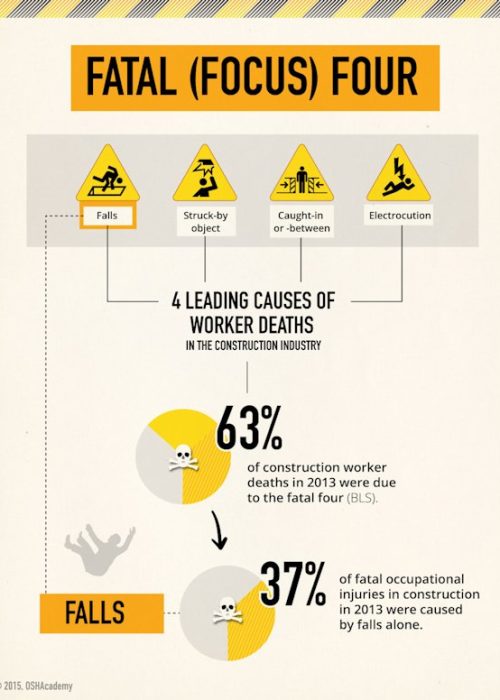This week (May 2nd – 6th) has been Construction Safety Week. Companies across the country participated in training, team bonding, and other activities that strengthened their company as a team and their safety protocol. Safety on every job site is the #1 priority for a construction company, and there are many laws and regulations to be followed to ensure every worker is safe. However, this week isn’t just about physically safety, but the mental wellness of our industry. This week, we will be discussing work-site safety hazards construction workers face every day, as well as the invisible and unspoken hazards that many face daily on site, and at home.
WARNING
This blog post contains discussion of suicide, self-injurious behavior, depression, and/or reference other mental health disorders that may act as triggers. Continue reading at your own discretion.
On job sites, there are many potential hazards from very simple fixes such as a clean workspace, organized cords, and open communication with all team members. OSHA has 4 top hazards that are present in the workspace due to improper use of equipment, or improper safety precautions in place. They call them the Four Focus Hazards – Falling, Struck-By, Caught Between, and Electrocution. These four areas represent almost 60% of all construction fatalities each year, with falling being the leading cause of death in construction workers. Electrocution is a major area of concern as construction workers are 4 times more likely to be electrocuted than workers in all other industries combined. ‘Struck-By’ hazards are due to objects falling, flying, swinging, or rolling. Hard hats play a huge roll in these types of hazards as materials are consistently being lifted or carried. It also includes vehicle and machinery accidents involving workers. ‘Caught Between’ can be due to poor worksite safety such as open moving parts of equipment, uncovered trenches and excavations, equipment situated on unstable ground, and even required tasks like demolishing walls. While these four hazards cover a large majority of those present in the industry, there are invisible hazards at work sites to be aware of.

Air hazards pose a major threat to construction workers, and even project owners, as they are unable to be seen with the naked eye. One of the most dangerous is asbestos, a naturally occurring mineral that is resistant to heat and corrosion. Asbestos was popular before the 80’s before being banned in 1989 from production of floor tiles, concrete, masonry, and insulation due to its linkage to mesothelioma – a fatal cancer found in the lungs and/or abdomen due to asbestos exposure. There is no level of safe asbestos, and many contractors go through extensive asbestos screening before demolition and renovations. This week, our field staff here at Laux Construction participated in Asbestos and Lead Awareness Training provided by Terry Welsh from ASHA Inc. Check out the photos on our Facebook page!
Another air hazard is asphalt fumes, also known as bitumen fumes. Over half a million construction workers are exposed to bitumen as it is extensively used in road paving, roofing, siding, and concrete work. If you are exposed, you’re likely to experience a headache, skin rash, fatigue, loss of appetite, throat and eye irritation, cough, and/or develop skin cancer. However, this can be controlled by substituting low-fuming asphalt, having workers wear PPE (Personal Protection Equipment), or bringing a heating system that maintains the heat of the asphalt to a consistent temperature and capture the harmful emissions.
However, one of the most dangerous unseen air hazards is dust. Dust can become combustible extremely easily if the concentration is just right, causing massive explosions of work sites and buildings. Combustible dust can be from materials such as wood, paper, plastics, grain, and others that are ground/cut to smaller pieces. However, materials that wouldn’t typically burn in large pieces, such as aluminum or iron, can become combustible when small enough particles are created. Between 1980 and 2005, 119 workers died and another 718 were injured due to dust explosions. Not only must construction workers be aware of dust hazards, but also firefighters as they could help the dust become more combustible rather than put out the fire.
Working in this dangerous industry subsequently causes stress, and physical pain. A harmful effect to the workers body is hearing loss. Three out of 5 workers are overexposed to loud noises on job sites which causes extreme damage to our ears when not protected. Some common signs of hearing loss are ringing, whistling, buzzing, or humming in one’s ears. It’s also found that those who work in construction longer without protection will double their hearing age, meaning a 25-year-old will have the hearing of a 50-year-old. This is an easy fix by contractors, and even workers themselves, supplying ear protection, such as ear plugs or noise cancelling headphones. However, when wearing protection, workers must have amazing communication about the job site, and have immense situational awareness to avoid other potential hazards.
With this industry being physically demanding, it’s playing a part in the opioid usage of America. When a patient is experiencing large amounts of pain, doctors tend to prescribe medication known as opioids. The most common are OxyContin, Vicodin, morphine, and methadone. They are usually prescribed in small doses as they can become very addictive, with 1 in 4 people prescribed becoming addicted to them. In 2020 alone, there were nearly 70,000 opioid related deaths in the U.S., a 39% increase from 2019, equating to 190 lives lost a day due to the drug. Construction work can cause great deals of pain, and 1 out of 3 workers deal with a musculoskeletal disorder (MSD), which are causes for opioid usage. In Massachusetts and Ohio, construction workers are 7 times more likely to die from opioid-related overdoes than the average worker. Detoxing, or simply not becoming addicted, is very hard for many, meaning we must address the baseline issue – the physical labor. By doing team stretches before the day or working more in teams to lift and move materials, we can lower the force on workers physical bodies and prevent causing pain that could result in opioid prescriptions.
Not only is this job physically demanding, but equally mentally and emotionally. Unfortunately, the construction industry had the highest rate of suicide of any industry with 53 out of 100,000 workers in 2015 and continues to be above the national average every year. With men being three times more likely to commit suicide than women, this statistic sadly makes sense with the industry being male dominated. It also requires workers to travel far from home, which can bring a sense of loneliness and makes people miss important family events. The physical exhaustion or pain workers face could also aid in the unfortunate decision to take one’s life. Mental health needs to be prioritized in the construction industry, and every workplace in general. With society becoming more vulnerable and open to talking about things that bother us, mental health advocacy and help is more powerful than ever before. This industry needs to come together, and work on allowing vulnerability in the workplace. Whether it be an Open-Door policy, weekly check ins, or team bonding where work isn’t discussed, anything could help someone!
The construction industry is one of the most dangerous in the world, but that doesn’t mean we can’t act and make positive efforts to relieve stress and potential hazards. By enforcing safety protocols, and getting to know one another on personal levels, we not only create a trusting and respectful environment, but also keep those we don’t know personally safe after the job is done. If you’ve enjoyed this blog, please share it with your family and friends, or reach out to those who could help you with whatever you need!
Share this Post




